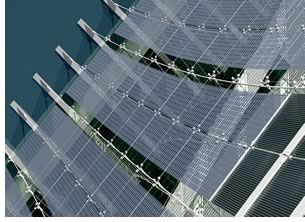

08/2005
Legislation also includes Sun Wall and PV Energy Commercialization programs
 With his signature August
8, President George W. Bush authorized the first national energy plan
in a decade. The final legislation contains several wins for architects
and their clients, including tax breaks for energy-efficient and sustainable
technologies, an AIA-backed photovoltaic commercialization program, and
funding for the AIA-sponsored “Sun Wall” project.
With his signature August
8, President George W. Bush authorized the first national energy plan
in a decade. The final legislation contains several wins for architects
and their clients, including tax breaks for energy-efficient and sustainable
technologies, an AIA-backed photovoltaic commercialization program, and
funding for the AIA-sponsored “Sun Wall” project.
“Even though the overall legislation disappointed many people and failed to address many crucial issues, it did provide us with a vehicle to attach important initiatives we favor,” says Tom Wolfe, senior director, AIA Federal Affairs.
Sun Wall
An intensive national AIA grassroots advocacy effort was instrumental
in obtaining inclusion within the bill of $20 million for construction
of a “Sun Wall” at the U.S. Department of Energy headquarters
in Washington, D.C. The AIA has championed this major federal renewable
energy/sustainable design project for more than five years. The wall
will generate 200 kW of electricity and be the largest building-integrated
solar-energy system on any federal building in the U.S. The design
incorporates PV panels with a solar thermal installation for hot water.
 An AIA and Energy Department competition called for a technologically
advanced and visually exciting solar-energy system for the 30,000-square-foot
blank south-facing wall of DOE’s Forrestal Building, close to the
National Mall in Washington, D.C. Less than 100 yards from a heavily
used commuter track, the project promises to show thousands of people
a day the potential beauty of pollution-free power. Martin Wolf, FAIA;
Mark Frisch, AIA; Devon Patterson, AIA; and Duane Carter, AIA, of Solomon
Cordwell Buenz & Associates, Chicago; and Mahadev Raman and David
M. Scott of engineer Ove Arup & Partners’ New York City office
created the design that captured the jurors’ attention in 2000.
An AIA and Energy Department competition called for a technologically
advanced and visually exciting solar-energy system for the 30,000-square-foot
blank south-facing wall of DOE’s Forrestal Building, close to the
National Mall in Washington, D.C. Less than 100 yards from a heavily
used commuter track, the project promises to show thousands of people
a day the potential beauty of pollution-free power. Martin Wolf, FAIA;
Mark Frisch, AIA; Devon Patterson, AIA; and Duane Carter, AIA, of Solomon
Cordwell Buenz & Associates, Chicago; and Mahadev Raman and David
M. Scott of engineer Ove Arup & Partners’ New York City office
created the design that captured the jurors’ attention in 2000.
“We realize that there are hurdles yet to overcome between legislation and eventual completion, however we are confident that with the continued support of the Congress, the public, and the American Institute of Architects, this project can be built. We hope this development will play a role in refocusing this country’s attention on the benefits of renewable, ecologically viable forms of energy,” Frisch says.
Photovoltaic Energy Commercialization Program
The bill also includes a photovoltaic energy commercialization program
for the U.S. General Services Administration. The measure, which will
help procure and install solar electric systems in new and existing
federal buildings, was a major part of the AIA’s federal issues
agenda.
Since early in the current Congress, the AIA has worked closely with U.S. Rep. James Oberstar (D-Minn.) to champion the measure, which aims to jump-start the market for photovoltaic systems and drive down production costs of photovoltaic equipment by ensuring a public-sector market. It would also stimulate the use of life-cycle analysis in federal procurement.
 Sustainable
Buildings Standards provision approved
Sustainable
Buildings Standards provision approved
The AIA and other groups supporting sustainable architecture captured
lawmakers’ attention on the issue of standards for high-performance
buildings. The legislation calls for DOE to enter into an agreement
with the National Institute of Building Sciences (NIBS) to:
- Assess whether current voluntary consensus-based standards and rating systems for sustainability in architecture are consistent with the current state of the art, including relevant research and development activities of the department
- Determine if additional research is needed to implement these standards
- Recommend steps for DOE to take to accelerate development of consensus standards for high-performance buildings.
The AIA Government Advocacy group will work with DOE to implement this effort. It is anticipated that life-cycle analysis of high-performance buildings is an area of common interest and may serve as a starting point for cooperation.
In a presentation August 9 sponsored by the Alliance to Save Energy, AIA President Douglas L Steidl, FAIA, said architects “need innovation to change how we build over the next 30 years.” Steidl also noted the need for better analysis of life-cycle costs that “measure and recognize” saved energy. In a recent column in AIArchitect, Steidl wrote that the issue is ultimately about the “p-word: profit.” “Every building owner will soon demand such design excellence,” Steidl said at the August presentation in Washington, D.C.
Copyright 2005 The American Institute of Architects.
All rights reserved. Home Page ![]()
![]()
